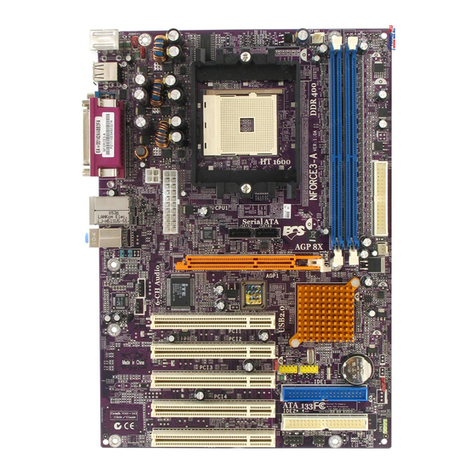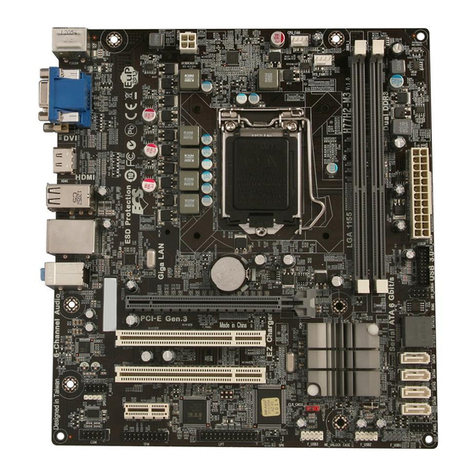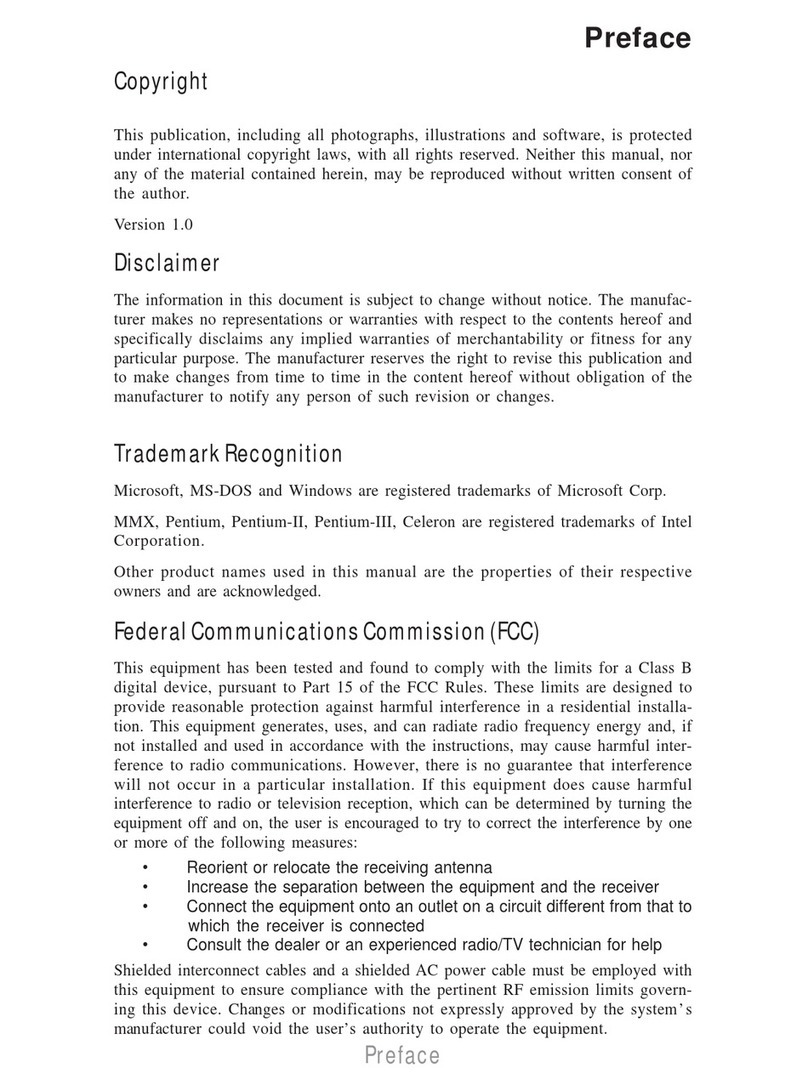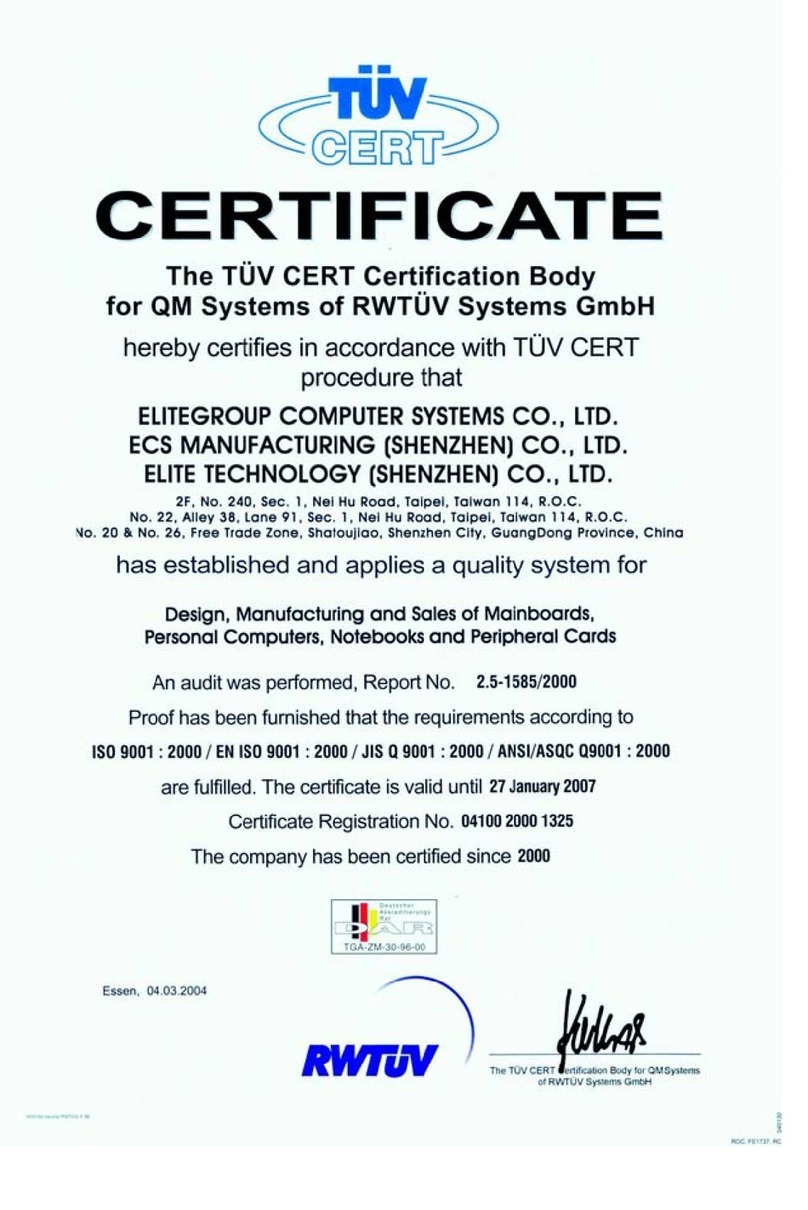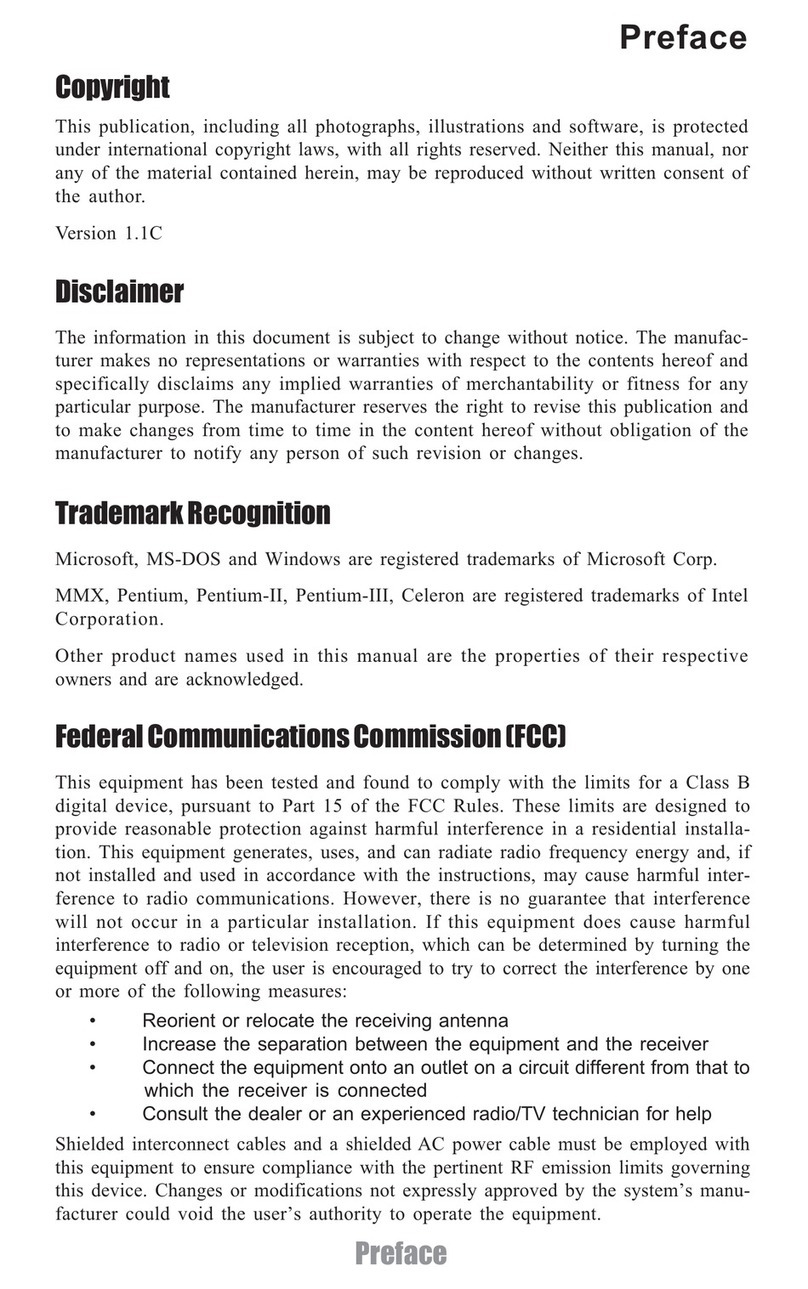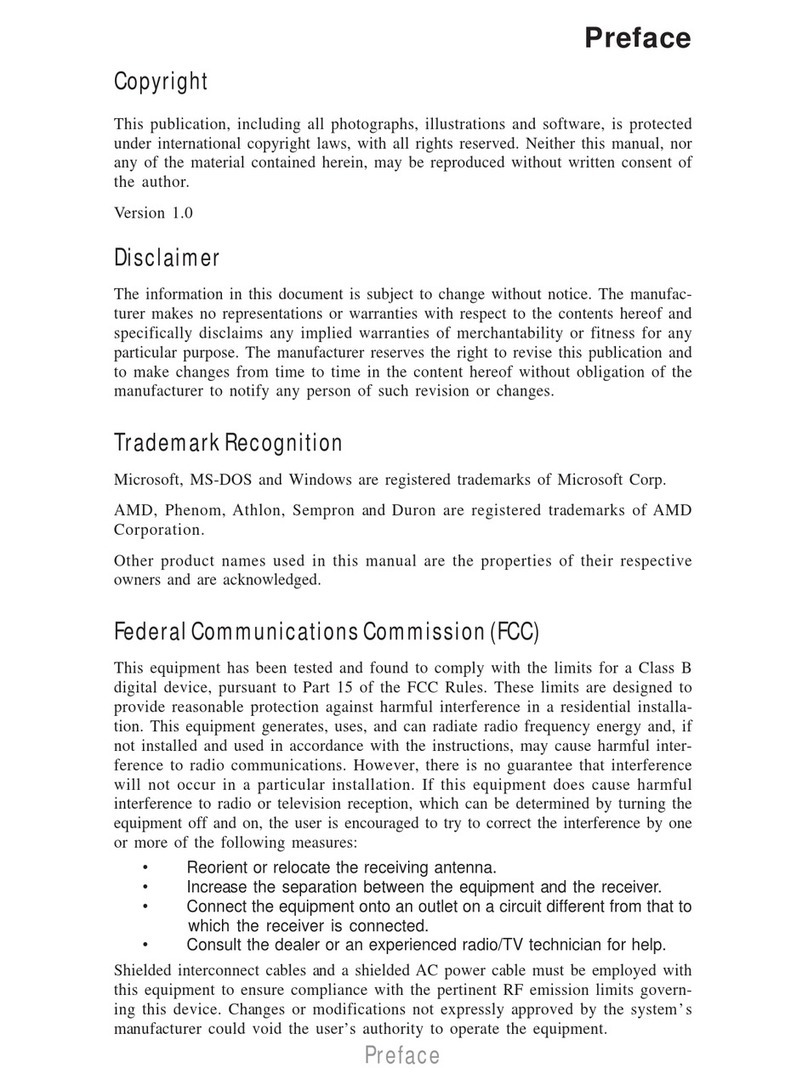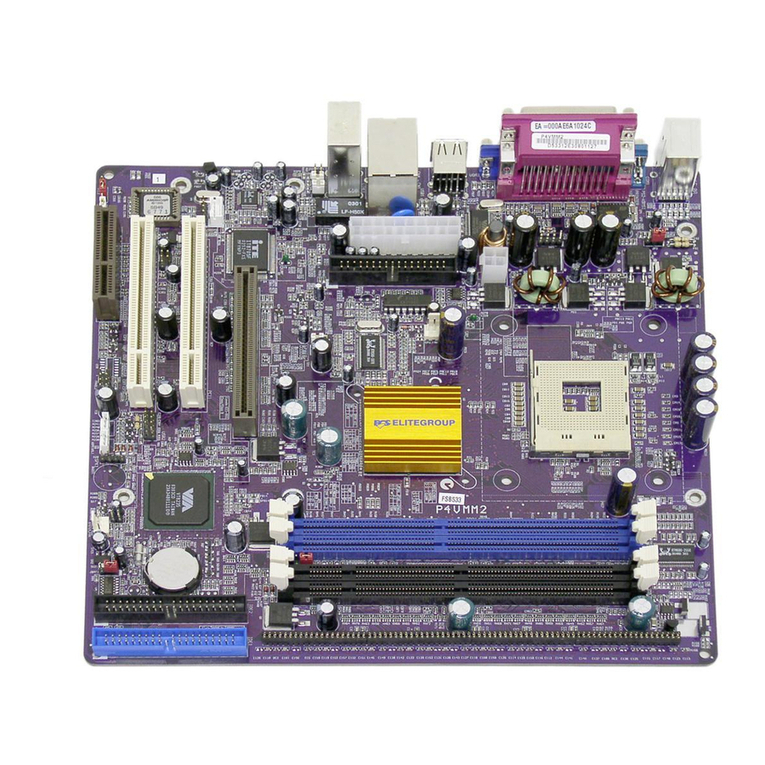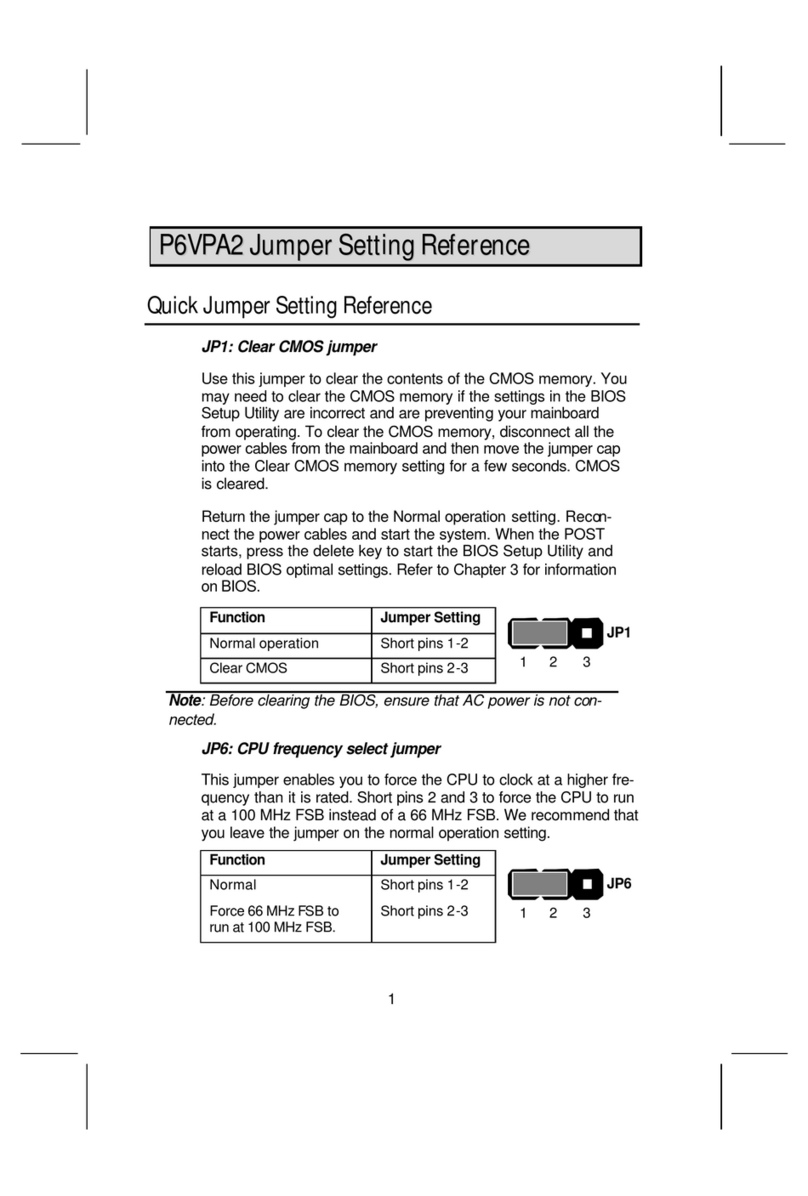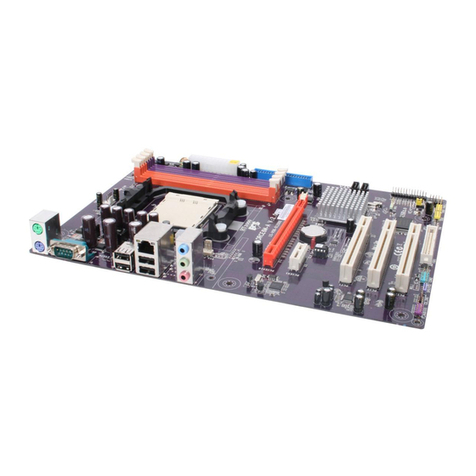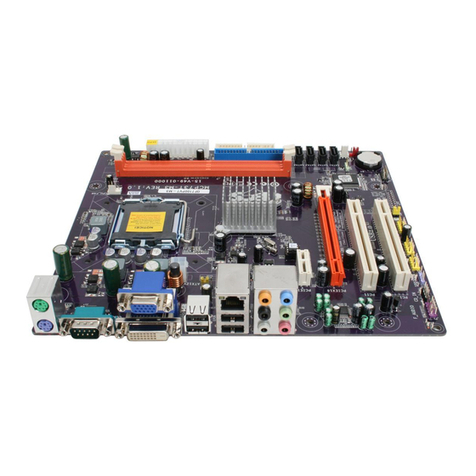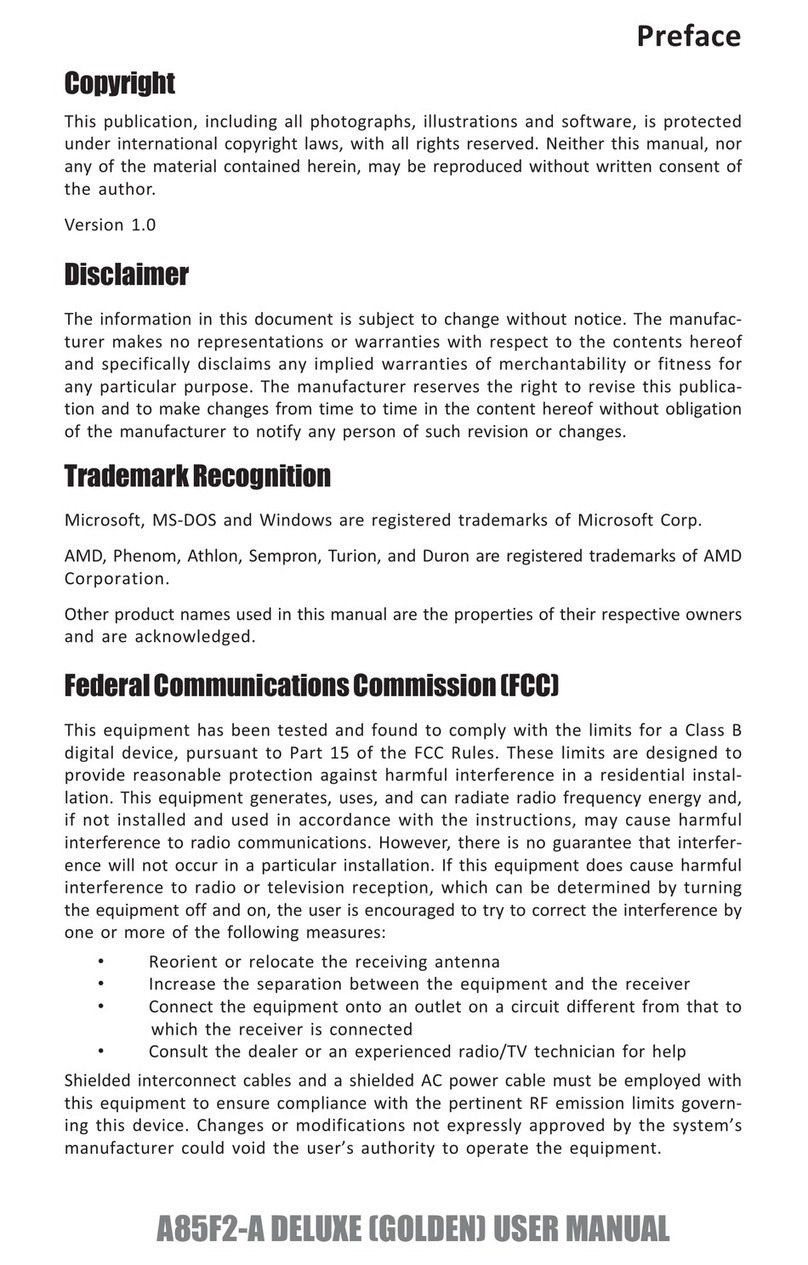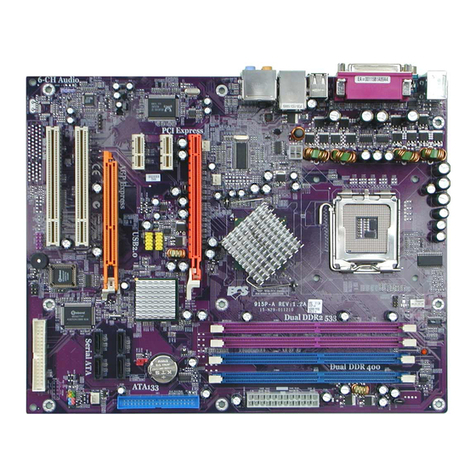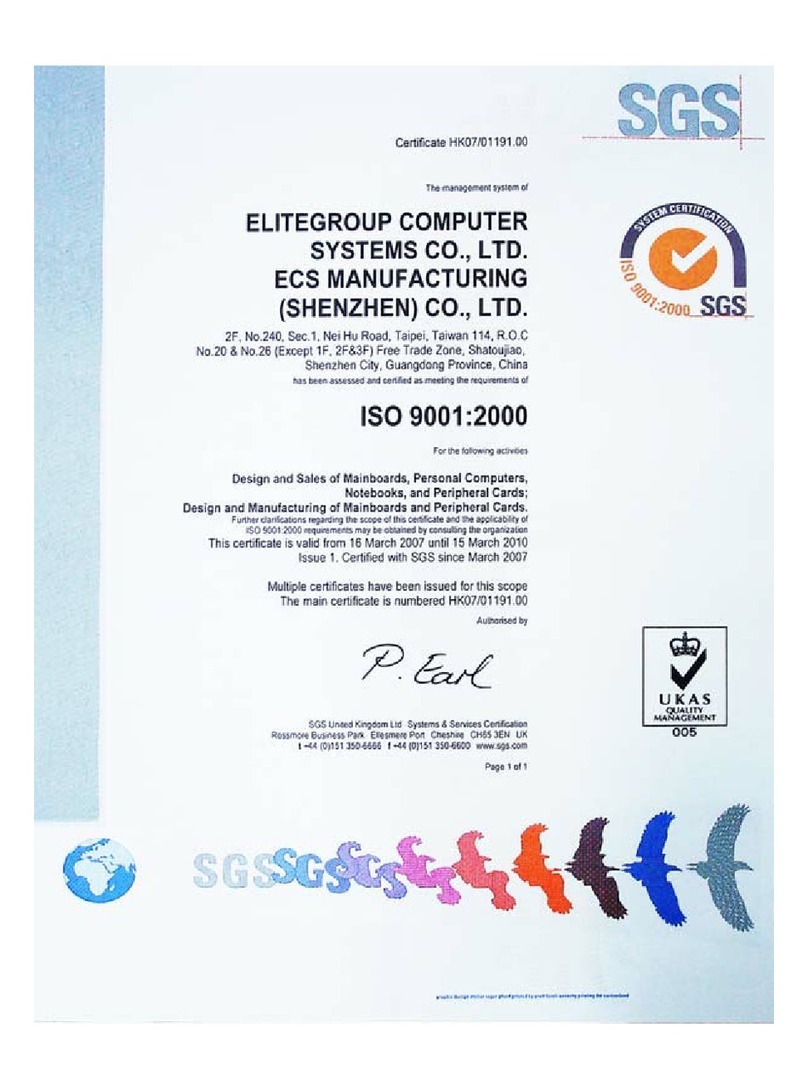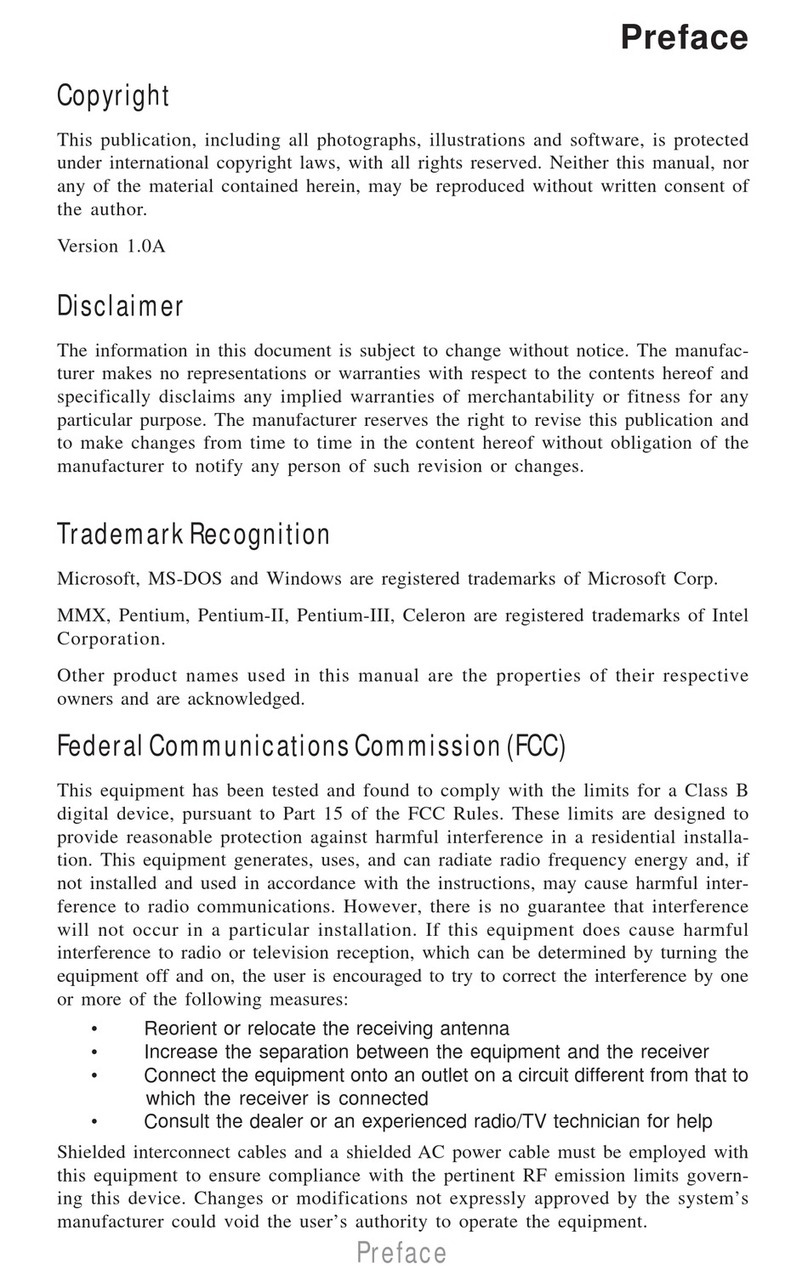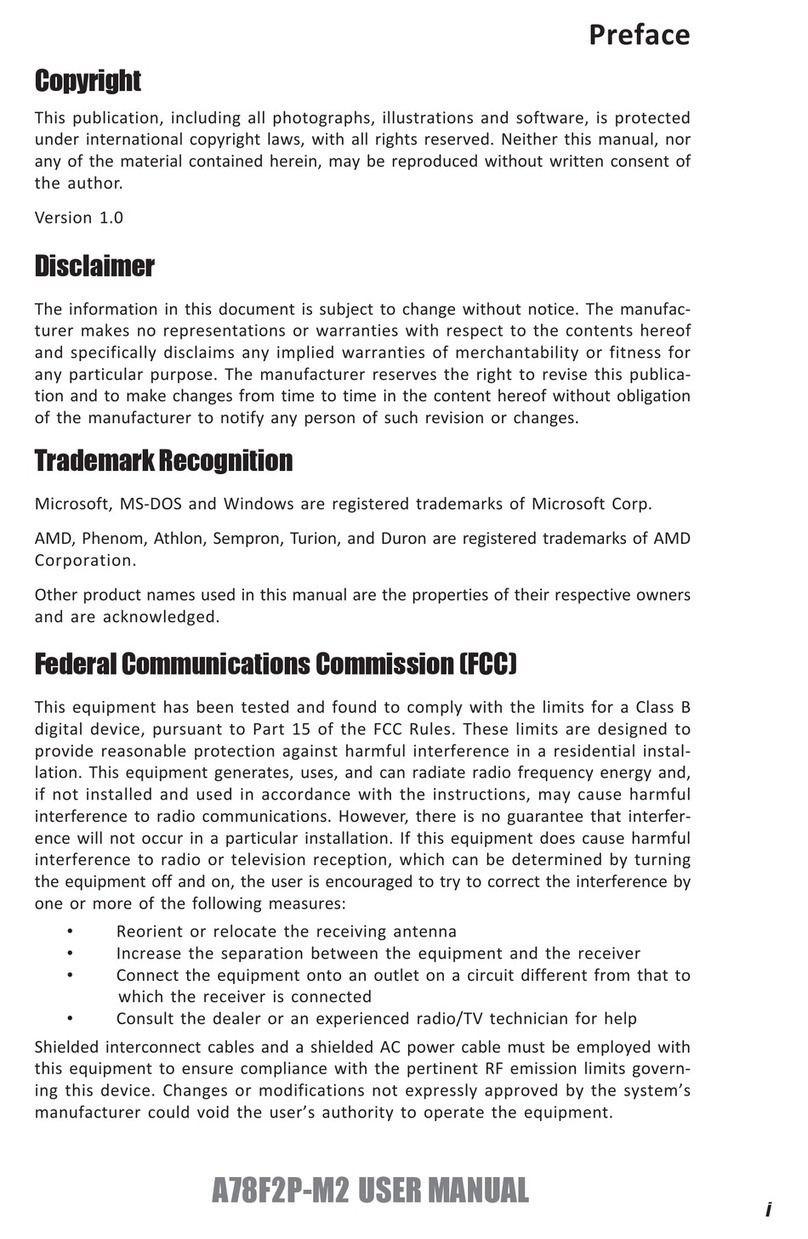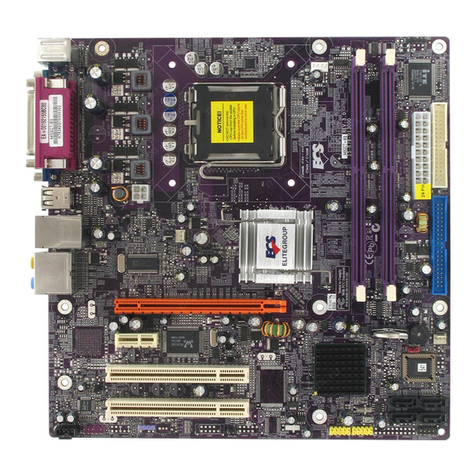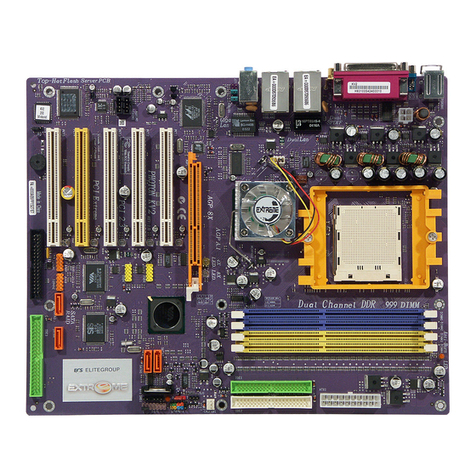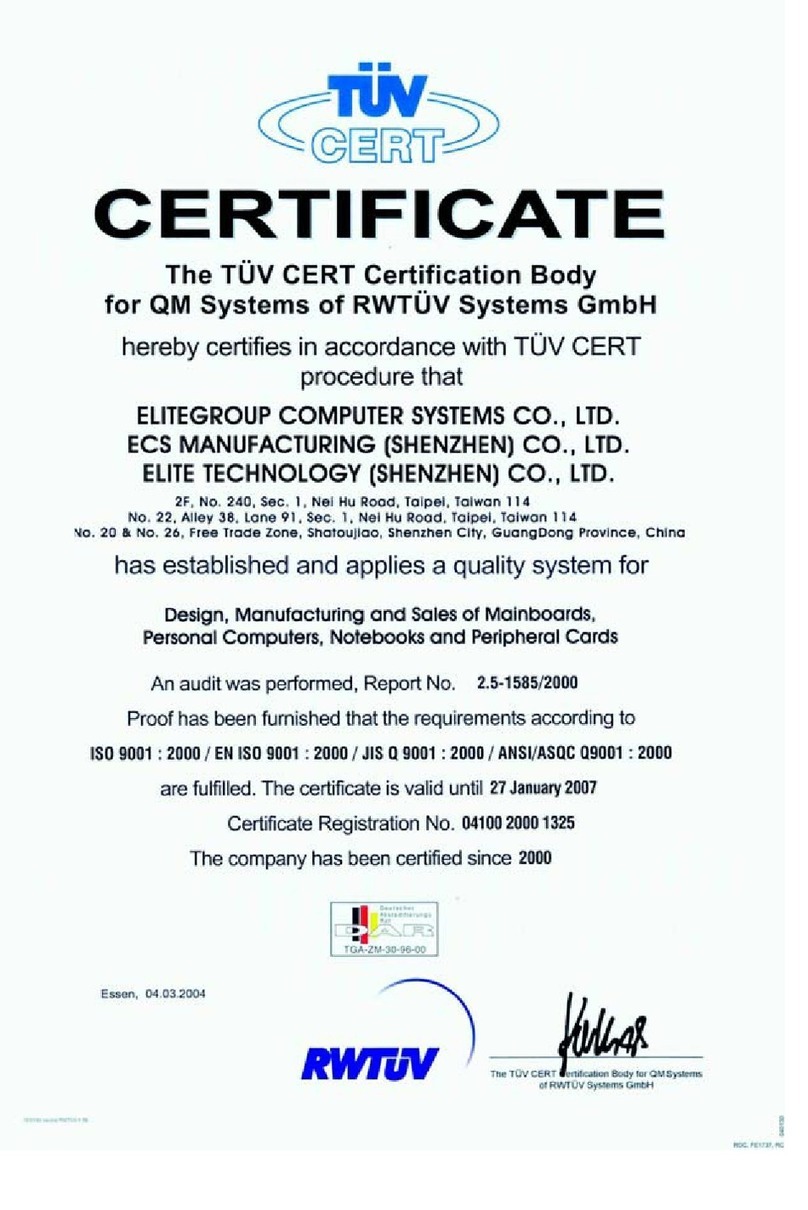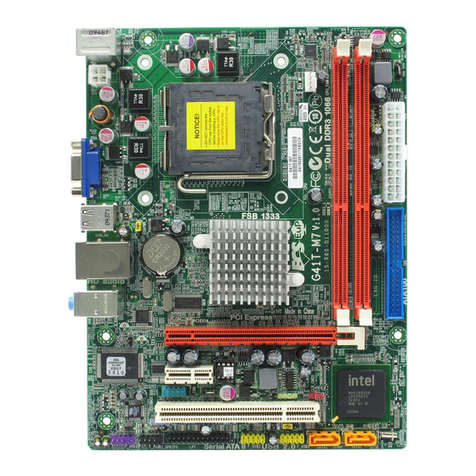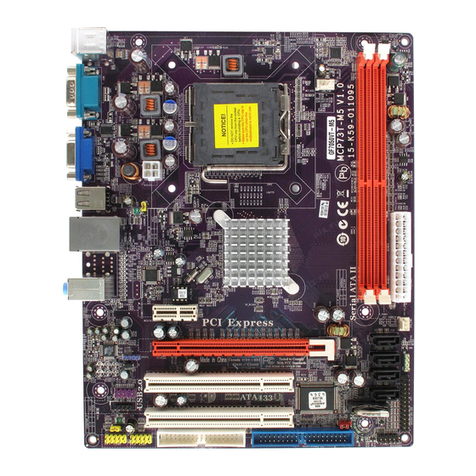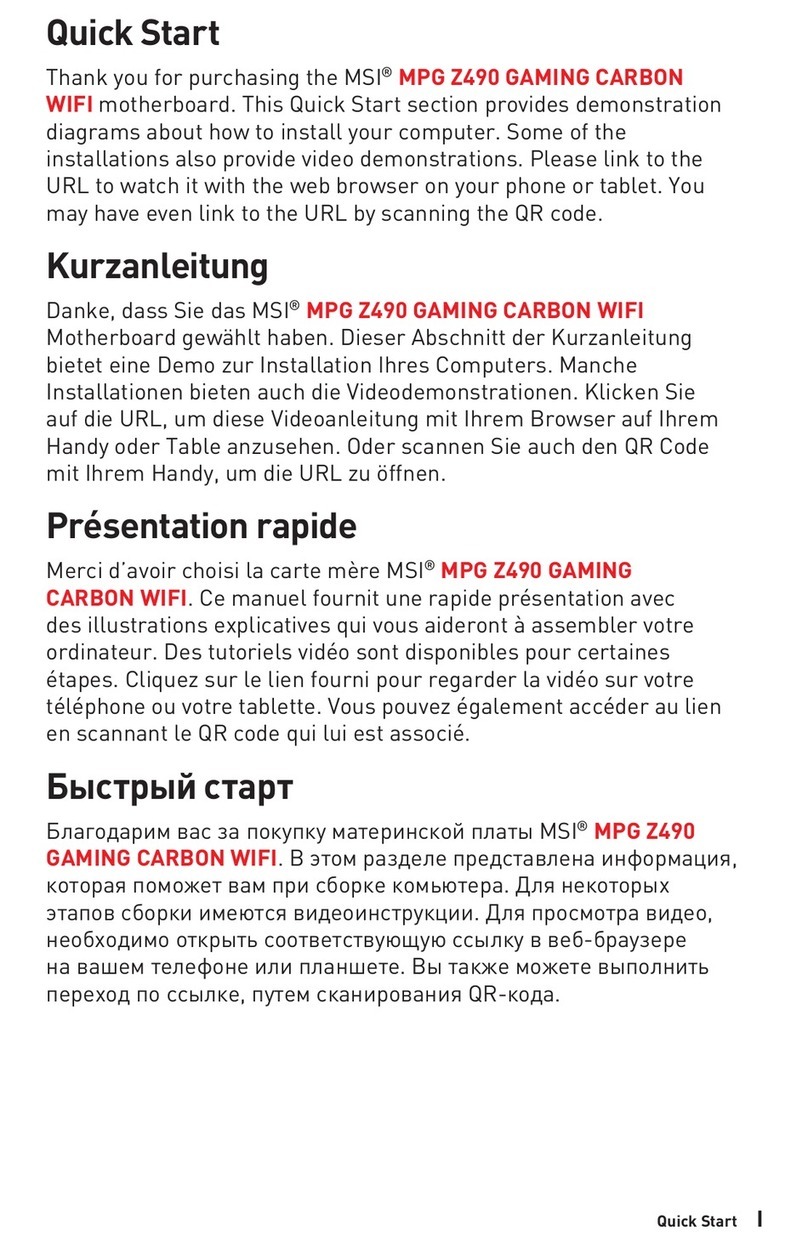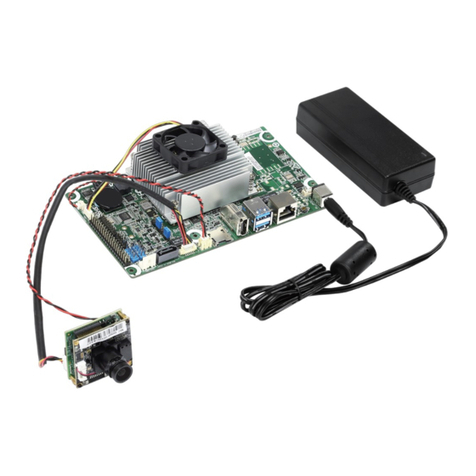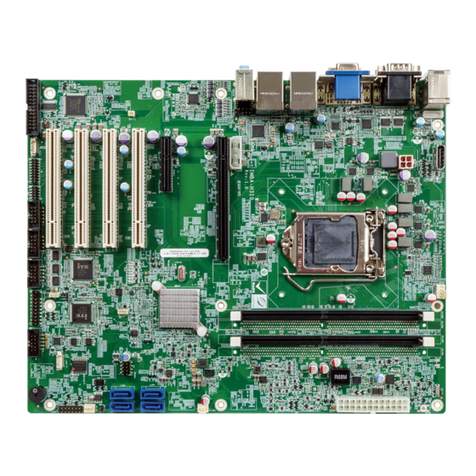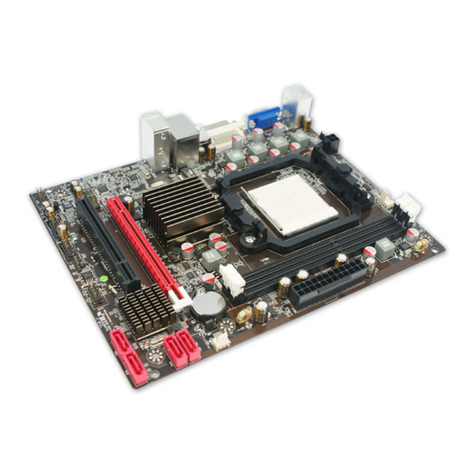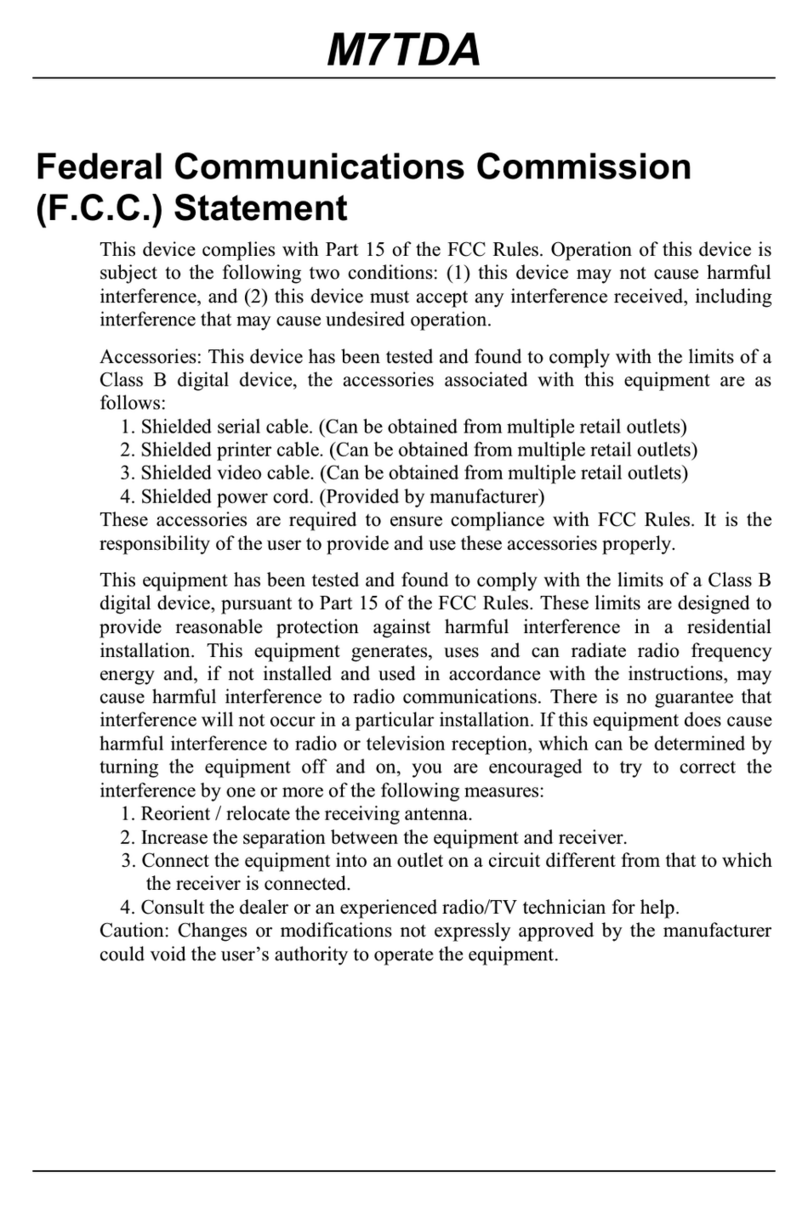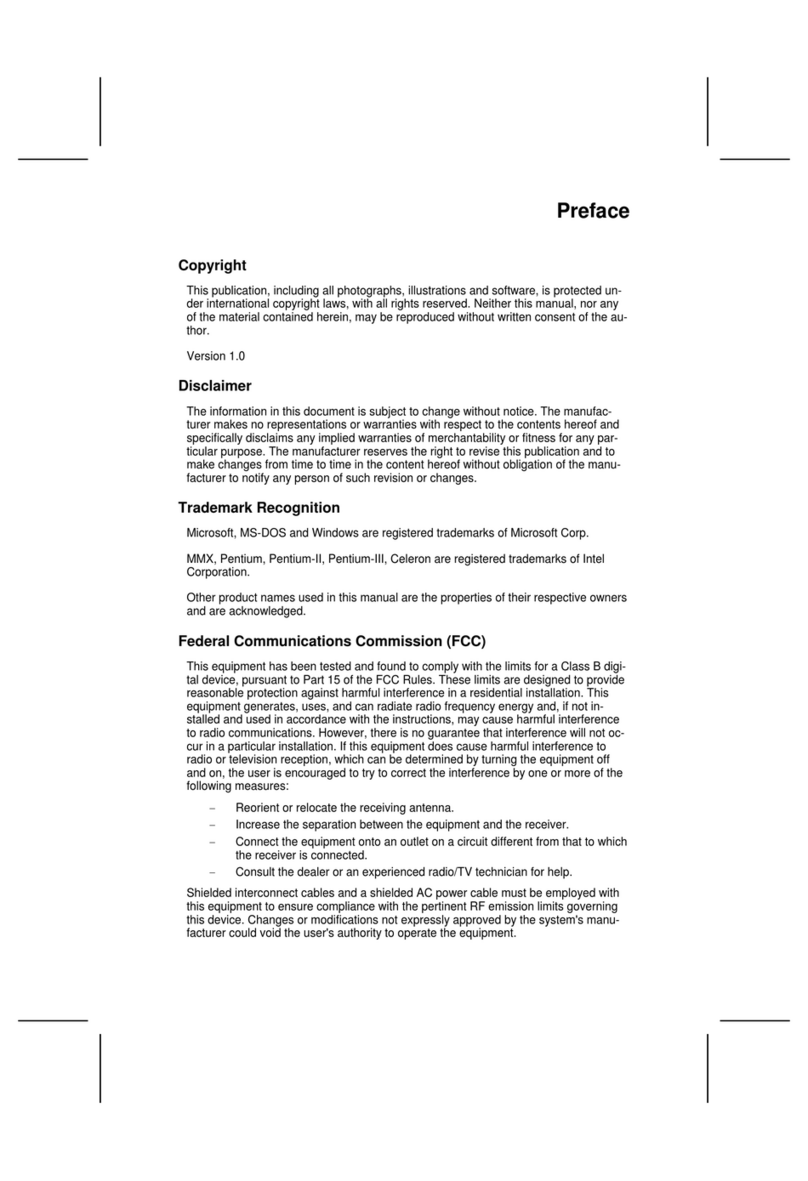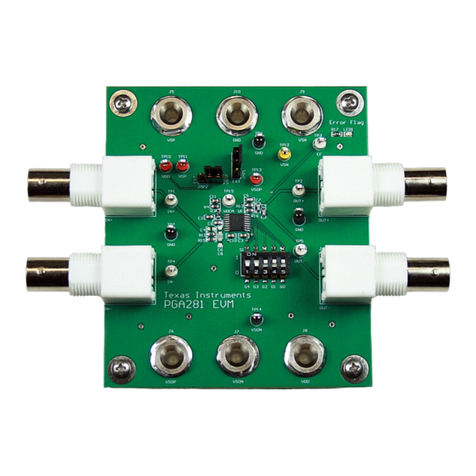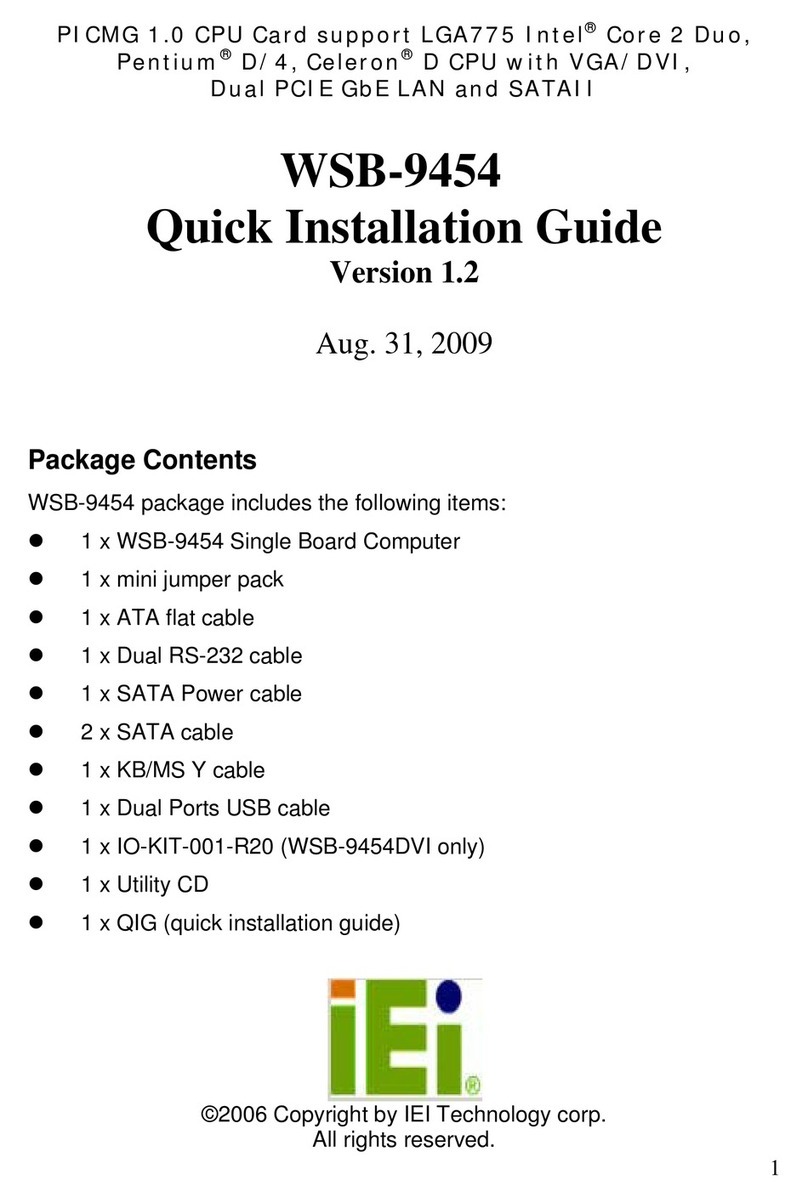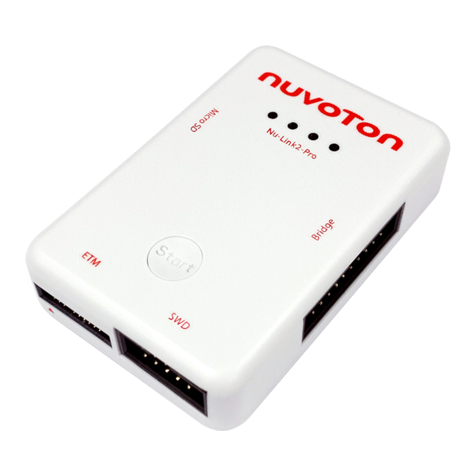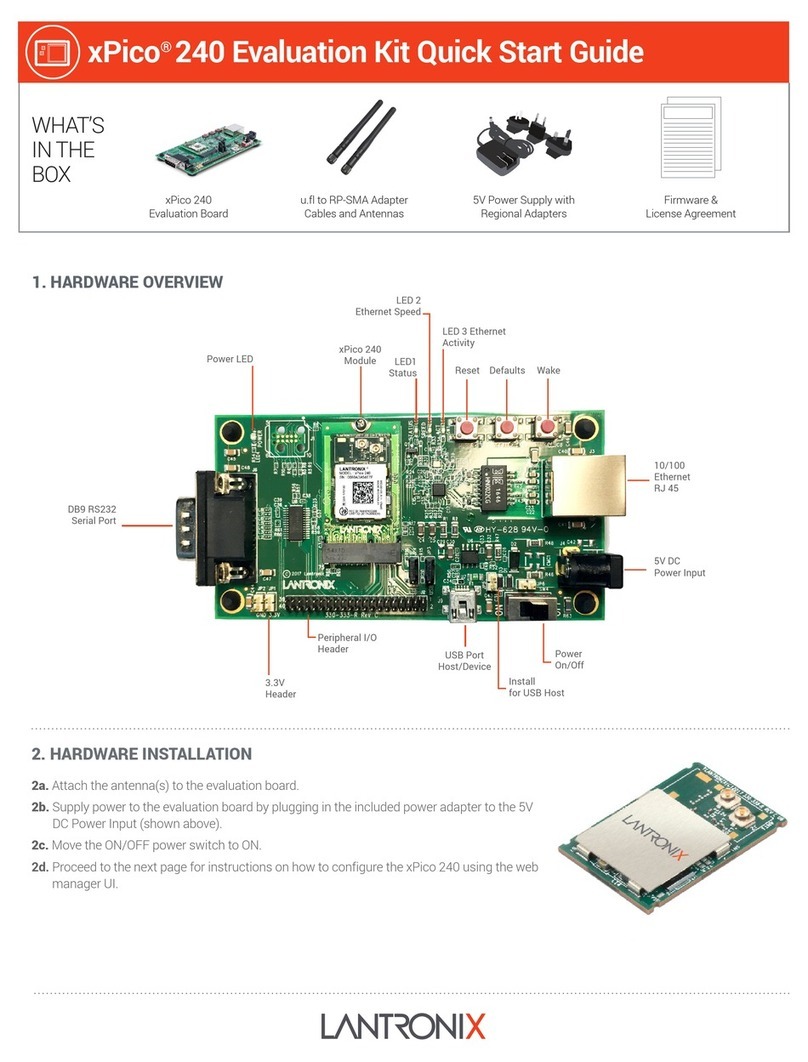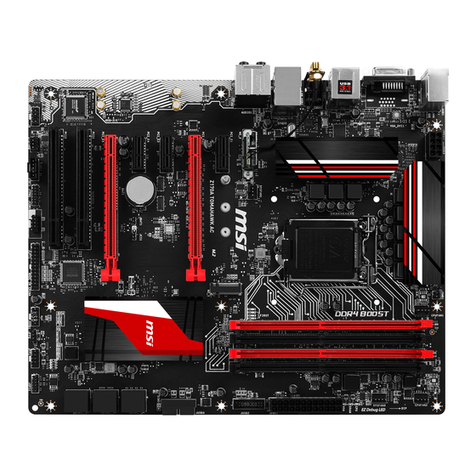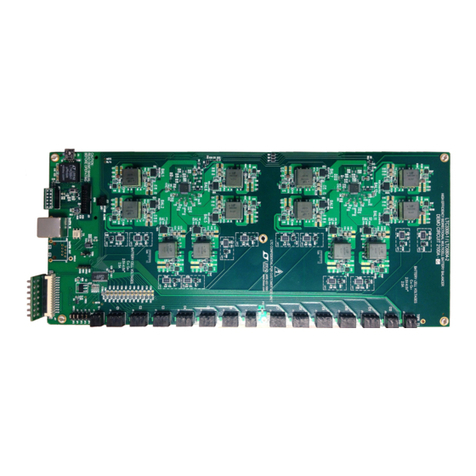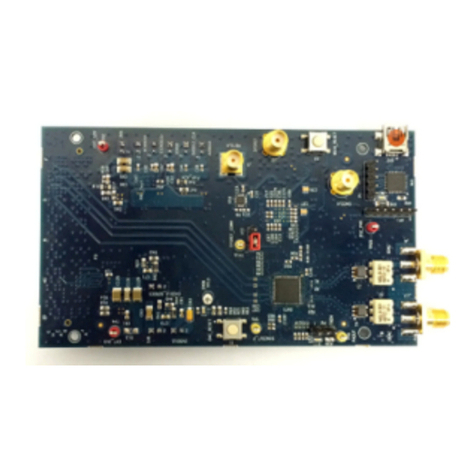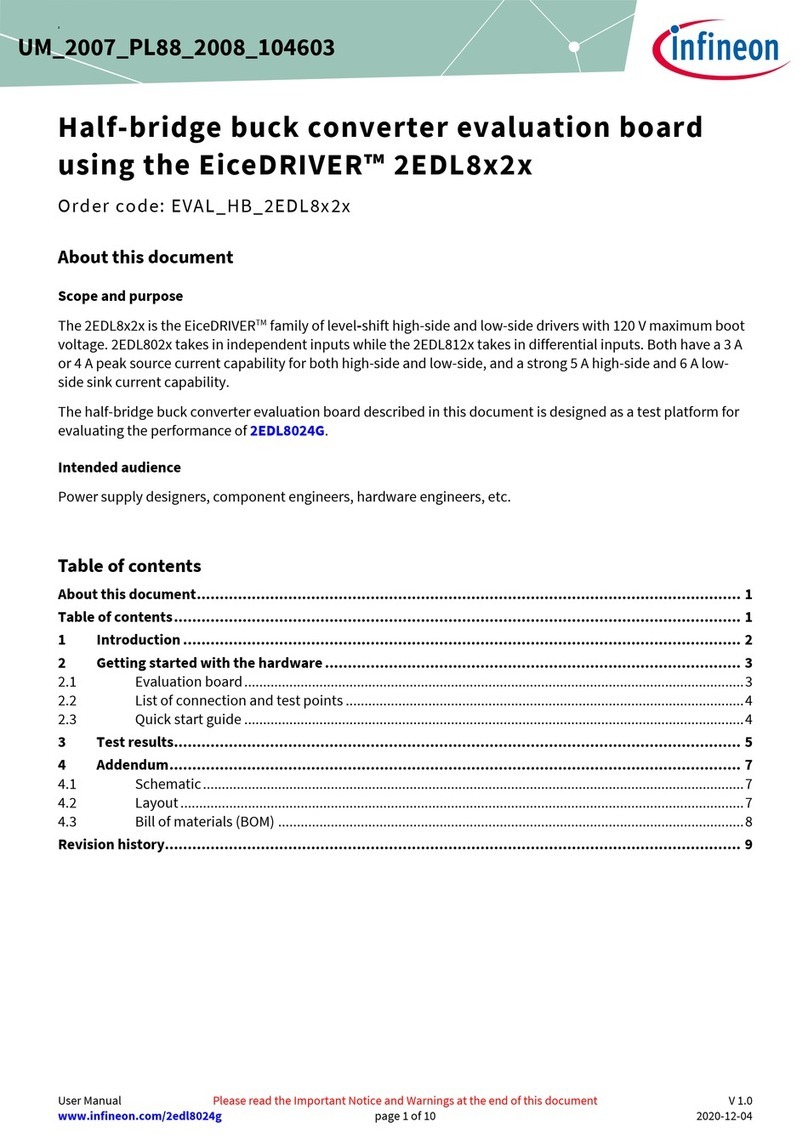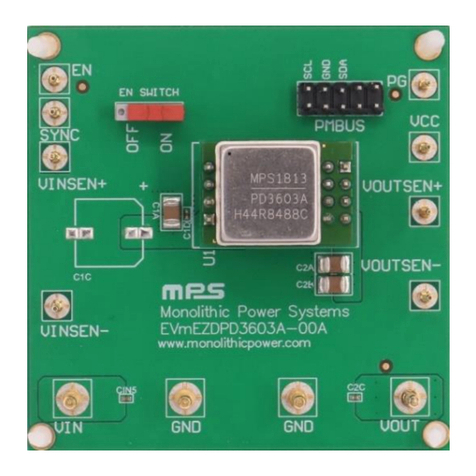ECS L7S7A User manual

Preface
Copyright
This publication, including all photographs, illustrations and software, is protected un-
der international copyright laws, with all rights reserved. Neither this manual, nor any
of the material contained herein, may be reproduced without written consent of the au-
thor.
Version 1.0
Disclaimer
The information in this document is subject to change without notice. The manufac-
turer makes no representations or warranties with respect to the contents hereof and
specifically disclaims any implied warranties of merchantability or fitness for any par-
ticular purpose. The manufacturer reserves the right to revise this publication and to
make changes from time to time in the content hereof without obligation of the manu-
facturer to notify any person of such revision or changes.
Trademark Recognition
Microsoft, MS-DOS and Windows are registered trademarks of Microsoft Corp.
MMX, Pentium, Pentium-II, Pentium-III, Celeron are registered trademarks of Intel
Corporation.
Other product names used in this manual are the properties of their respective owners
and are acknowledged.
Federal Communications Commission (FCC)
This equipment has been tested and found to comply with the limits for a Class B digi-
tal device, pursuant to Part 15 of the FCC Rules. These limits are designed to provide
reasonable protection against harmful interference in a residential installation. This
equipment generates, uses, and can radiate radio frequency energy and, if not in-
stalled and used in accordance with the instructions, may cause harmful interference
to radio communications. However, there is no guarantee that interference will not oc-
cur in a particular installation. If this equipment does cause harmful interference to
radio or television reception, which can be determined by turning the equipment off
and on, the user is encouraged to try to correct the interference by one or more of the
following measures:
−Reorient or relocate the receiving antenna.
−Increase the separation between the equipment and the receiver.
−Connect the equipment onto an outlet on a circuit different from that to which
the receiver is connected.
−Consult the dealer or an experienced radio/TV technician for help.
Shielded interconnect cables and a shielded AC power cable must be employed with
this equipment to ensure compliance with the pertinent RF emission limits governing
this device. Changes or modifications not expressly approved by the system's manu-
facturer could void the user's authority to operate the equipment.

ii
Declaration of Conformity
This device complies with part 15 of the FCC rules. Operation is subject to the follow-
ing conditions:
−This device may not cause harmful interference, and
−This device must accept any interference received, including interference
that may cause undesired operation.
Canadian Department of Communications
This class B digital apparatus meets all requirements of the Canadian Interference-
causing Equipment Regulations.
Cet appareil numérique de la classe B respecte toutes les exigences du Réglement
sur le matériel brouilieur du Canada.
About the Manual
The manual consists of the following:
Chapter 1
Introducing the Mainboard
Describes features of the mainboard,
and provides a shipping checklist.
Go to ⇒page 1
Chapter 2
Installing the Mainboard
Describes installation of mainboard
components.
Go to ⇒page 8
Chapter 3
Using BIOS
Provides information on using the BIOS
Setup Utility.
Go to ⇒page 28
Chapter 4
Using the Mainboard Software
Describes the mainboard software.
Go to ⇒page 43

iii
Features and Packing List Translations
Liste de contrôle
Comparez ce qui est contenu dans l'emballage de la carte mère avec la liste
suivante:
Eléments standards
•Une carte mère
•Un câble plat pour lecteur de disquette
•Un câble plat pour lecteur IDE
•Un CD d'installation automatique pour le logiciel
•Un écran pour panneau arrière d'entrées/sorties
•Un module de rétention
•Ce manuel utilisateur
Caractéristiques
Processeur La carte mère utilise un Socket A AMD 462 broches
supportant un bus frontal (FSB) de 133/166 MHz
Chipset Les chipsets SiS746 et SiS963/963L sont basés sur une
architecture novatrice et dimensionnable avec une fiabilité et
des performances prouvées. Quelques-unes des
caractéristiques avancées des chipsets sont:
•Supporte le CPU de Socket A AMD: 133/166 MHz
•Supporte la synchronisation Synchrone/Asynchrone
Hôte-t-DRAM: 133/200, 133/266, 133/333, 166/266,
166/333
•Supporte les SDRAM DDR 200/266/333
•Support jusqu’à 2 DIMM DDR333 sans tampon ou
jusqu’à 3 DIMM DDR266/200 sans tampon double face
•Conforme AGP v3.0
•Bus de données 16 bits Bi-directionnel
•Performances de 1 Go/s en mode 133MHz x 4
•Conforme aux Spécifications PCI 2.2
•Maîtrise de Liaison d’E/S Multiprocessus Intégrée avec
Flux en Pipeline de Lecture
•Supporte les schémas de Logiciel Amélioré et
Automatique pour accéder aux registres PHY
•Supporte Ultra DMA 33/66/100/133
•Compatible USB v2.0 et Interface de Contrôleur d’Hôte
Avancé (EHCI) v1.0
Les caractéristiques clé supplémentaires incluent le support
pour six ports USB 2.0, contrôleur Fast Ethernet MAC,
interface AC97, contrôleur d’hôte IEEE 1394 (excepté pour le
chipset SiS963L Southbridge), gestion d’alimentation avancée,
contrôleur DMA intégré et contrôleur de clavier.
Mémoire •Support de module mémoire DDR SDRAM jusqu’à
200/266/333 MHz
•Peut recevoir trois logements sans mémoire tampon en
2.5V de 184 broches

iv
•Chaque logement supporte jusqu’à 1 Go avec une
capacité maximum totale de 3 Go.
AGP La L7S7A inclus un logement AGP qui offre huit fois la bande
passante des spécifications AGP d’origine. L’AGP 3.0 (8xAGP)
offre une amélioration significative de performances
accompagnée d’améliorations de fonctionnalités sur l’AGP2.0.
Cette interface représente l’évolution naturelle de l’AGP
existante pour répondre à une demande toujours croissante
d’interfaces graphiques en environnements de station de
travail et de bureau.
Codec Audio
AC’97
Le codec Audio AC 97 est conforme aux spécifications de AC
97 2.2, et supporte la résolution ADC (Analog Digital
Converter) 18 bits et DAC (Digital Analog Converter) ainsi que
le codec stéréo 18 bits full-duplex avec des vitesses
d’échantillonnage indépendantes et variables. Les fonctions
supplémentaires comprennent le support de quatre entrées
stéréo de niveau de ligne analogique.
Options
d’Extensions
La carte mère est livrée avec les options d’extensions
suivantes:
•Cinq logements PCI 32 bits
•Un logement AGP (supporte l’Interface AGP 1.5V
seulement)
•Un logement Communications Network Riser (CNR)
(Interface AC97 seulement)
•Deux connecteurs IDE supportant quatre canaux IDE et
une interface de lecteur de disquette
La L7S7A supporte la maîtrise de bus Ultra DMA avec des
vitesses de transfert de 33/66/100 Mo/sec.
ATA Série
Sil3112A
(optionnel)
•Liaison ATA Série intégrée et PHY logic
•Conforme aux spécifications ATA Série 1.0
•Supporte deux canaux ATA Série indépendants
•Supporte la vitesse de transfert ATA Série Génération 1
de 1.5Go/s
•Supporte l’Etalement du Spectre en récepteur
•Architecture PLL unique, 1 PLL pour chacun des ports
La puce LAN Realtek RTL8100B est incorporée dans le
chipset offrant à la carte mère les capacités de contrôleur fast
Ethernet 10/100Mbps et LAN PCI Ethernet intégrées.
LAN Interne
(optionnel)
RTL8201BL est un Fast Ethernet Phyceiver avec un MII
(Media Independent Interface)/SNI (Serial Network Interface).
Il peut être utilisé comme Adaptateur d’Interface Réseau,
MAU, CNR, ACR, Hub Ethernet, et Commutateur Ethernet.
Interface de
Contrôleur IEEE
1394A
(optionnel)
•Support entièrement les provisions de IEEE1394-1995
pour Bus Série à Hautes Performances et le standard
P1394a draft 2.0
•Offre un port de câble conforme à 100Mbits/s,
200Mbits/s, et 400Mbits/s
•Supporte la réinitialisation de bus court arbitré pour
améliorer l’utilisation du bus
•Interface de données pour contrôleur de liaison-couche
fourni à travers les lignes parallèles 2/4/8 à 50Mbits/s
•Support la fonction de coupure de courant pour
économiser l’énergie dans les applications alimentées par
batteries

v
E/S Intégrée La carte mère possède un jeu complet de ports d’E/S et de
connecteurs:
•Deux ports PS/2 pour souris et clavier
•Deux ports série
•Un port parallèle
•Un port MIDI/jeu
•Deux ports USB
•Un port LAN
•Prises audio pour microphone, ligne d’entrée et ligne de
sortie
Microprogramme
BIOS
Cette carte mère utilise AMI BIOS qui permet aux utilisateurs
de configurer de nombreuses fonctionnalités du système y
compris les suivantes :
•Gestion d’alimentation
•Alarmes de réveil
•Paramètres de CPU
•Synchronisation de CPU et de mémoire
Le microprogramme peut aussi être utilisé pour définir les
paramètres pour les vitesses d’horloges de différents
processeurs.

vi
Checkliste
Vergleichen Sie den Packungsinhalt des Motherboards mit der folgenden
Checkliste:
Standard Items
•Ein Motherboard
•Ein Bandkabel für Diskettenlaufwerke
•Ein Bandkabel für IDE-Laufwerke
•Eine Auto-Installations-Support-CD
•I/O-Anschlussabdeckung für die Rückwand
•Ein Kühlkörperhalter
•Dieses Benutzerhandbuch
Features
Prozessor Das Mainboard verwendet einen AMD 462-Pin Sockel A, der
einen 133/166 MHz Frontsidebus (FSB) unterstützt.
Chipsatz Die Chipsätze SiS746 und SiS963/963L basieren auf einer
innovativen und skalierbaren Architektur mit bewiesener
Zuverlässigkeit und Leistung. Einige der modernen
Eigenschaften des Chipsatzes:
•Unterstützt AMD Sockel A CPU: 133/166 MHz
•Synchrones/Asynchrones Host-t-DRAM-Timing: 133/200,
133/266, 133/333, 166/266, 166/333
•Unterstützt 200/266/333 DDR SDRAM
•Unterstützt bis zu 2 ungepufferte DIMM DDR333 oder bis
zu 3 ungepufferte doppelseitige DIMM DDR266/200
•Entspricht AGP v3.0
•Bi-direktionaler 16 Bit Datenbus
•Leistung von 1 GB/s im 133MHz x 4 Modus
•Entspricht PCI 2.2 Spezifikation
•Eingebautes Multithreaded I/O-Link-Mastering mit Read-
Pipelined-Streaming
•Unterstützt Enhanced Software- und Automatic-
Schemen, um auf PHY-Verzeichnisse zuzugreifen
•Unterstützt Ultra DMA 33/66/100/133
•Kompatibel mit USB v2.0 und Enhanced Host Controller
Interface (EHCI) v1.0
Zusätzliche Schlüsseleigenschaften umfassen die Unterstützung
für sechs USB-Anschlüsse, Fast Ethernet MAC Controller, AC
97-Interface, IEEE 1394 Host Controller (ausgenommen Chipsatz
SiS963L Southbridge), erweiterte Energieverwaltung, integrierter
DMA Controller und Tastatur Controller.
Speicher •Unterstützt DDR bis zu 200/266/333 MHz SDRAM-
Speichermodul
•Nimmt drei ungepufferte 2.5V 184-Pin Steckplätze auf
•Jeder Steckplatz unterstützt bis zu 1 GB mit einer
maximalen Gesamtkapazität von bis zu 3 GB

vii
AGP Das L7S7A enthält einen AGP-Steckplatz mit der achtfachen
Bandbreite der ursprünglichen AGP-Spezifikation. AGP 3.0
(8xAGP) bietet gegenüber AGP2.0 eine erhebliche
Leistungssteigerung und verbesserte Features. Dieses Interface
stellt die natürliche Weiterentwicklung des bestehenden AGP dar,
um den stetig anwachsenden Anforderungen an die
Grafikschnittstellen innerhalb der Workstations und Desktop-
Umgebungen gerecht zu werden.
AC’ 97 Audio
Codec
Der AC’ 97 Audio-Codec entspricht der AC’ 97 2.2-
Spezifikation und unterstützt 18-Bit ADC (Analog Digital
Converter) und DAC (Digital Analog Converter)-Auflösungen
sowie 18-Bit-Stereo-Vollduplex-Codec mit unabhängigen und
variablen Samplingraten. Weitere Eigenschaften umfassen die
Unterstützung für vier analoge Line-Level-Stereoeingänge.
Erweiterungs-
optionen
Das Mainboard bietet die folgenden Erweiterungsoptionen:
•Fünf 32-bit PCI-Steckplätze
•Einen AGP-Steckplatz (unterstützt nur 1.5V AGP
Interface)
•Einen Steckplatz für Communications Network Riser
(CNR) (nur AC97-Interface)
•Zwei IDE-Stecker, die vier IDE-Kanäle und eine
Schnittstelle für ein Floppydiskettenlaufwerk unterstützen
Das L7S7A unterstützt Ultra DMA Bus-Mastering mit
Übertragungsraten von 33/66/100 MB/s.
Sil3112A Serial
ATA (optional)
•Integriertes Serial ATA-Link und PHY-Logic
•Entspricht Serial ATA 1.0 Spezifikationen
•Unterstützt zwei unabhängige Serial ATA-Kanäle
•Unterstützt Serial ATA Generation 1 Transferrate von
1.5Gb/s
•Unterstützt Spread Spectrum im Empfänger
•Single-PLL-Architektur, 1 PLL für beide Schnittstellen
Der Realtek RTL8100B LAN-Chip ist im Chipsatz eingebaut
und bietet dem Mainboard damit einen 10/100Mbps Fast
Ethernet Controller und integrierte Ethernet PCI LAN
Fähigkeit.
Onboard LAN
(optional)
RTL8201BL ist ein Fast Ethernet Phyceiver mit MII (Media
Independent Interface)/SNI (Serial Network Interface). Er kann
als Network Interface Adapter, MAU, CNR, ACR, Ethernet Hub
und Ethernet Switch verwendet werden.
IEEE 1394A
Controller
Interface
(optional)
•Vollständige Unterstützung der Bereitstellung von IEEE
1394-1995 für Hochleistungs-Serial Bus und P1394a
Entwurf 2.0 Standard
•Bietet einen kompatiblen Kabelanschluss bei 100Mbits/s,
200Mbits/s und 400Mbits/s
•Unterstützt Arbitrated-Short-Bus-Reset, um die Bus-
Nutzung zu verbessern
•Datenschnittstelle zum Link-Layer Controller durch 2/4/8
parallele Leitungen bei 50Mbits/s
•Unterstützt Abschaltfunktion, um in den
batteriebetriebenen Anwendungen Energie zu sparen

viii
Integrierte I/O Das Mainboard verfügt über einen kompletten Satz von I/O-
Schnittstellen und Anschlüssen:
•Zwei PS/2-Schnittstellen für Maus und Tastatur
•Zwei serielle Schnittstellen
•Eine parallele Schnittstelle
•Eine MIDI/Game-Schnittstelle
•Zwei USB-Schnittstellen
•Eine LAN-Schnittstelle
•Audiobuchsen für Mikrofon, Line-in und Line-out
BIOS-Firmware Dieses Mainboard setzt das AMI BIOS ein, mit dem der
Anwender viele Systemeigenschaften selbst konfigurieren
kann, einschließlich der folgenden:
•Energieverwaltung
•Wake-up-Alarm
•CPU-Parameter
•CPU und Speichertiming
Mit der Firmware können auch die Parameter für verschiedene
Prozessortaktgeschwindigkeiten eingestellt werden.

ix
Lista di controllo
Comparate il contenuto della confezione della scheda madre con la seguente
lista di controllo:
Articoli standard
•Una scheda madre
•Un cavo a nastro per il drive dischetti
•Un cavo a nastro IDE
•Un CD di supporto software auto-installante
•Una protezione per il pannello posteriore di I/O
•Un modulo di ritenzione
•Il manuale dell’utente
Caratteristiche
Processore La scheda madre utilizza una piattaforma socket A a 462 pin
AMD che supporta un front side bus (FSB) a 133/166 Mhz.
Chipset I chipset SiS746 e SiS963/963L sono basati su un'architettura
innovativa e scalabile di provata affidabilità e di eccellenti
prestazioni. Di seguito vengono illustrate alcune delle
avanzate caratteristiche del chipset:
•Supporta una CPU AMD con socket A da 133/166 Mhz
•Host-t-DRAM timing sincrono/asincrono: 133/200,
133/266, 133/333, 166/266, 166/333
•Supporta una DDR SDRAM da 200/266/333 Mhz
•Supporta fino a 2 DIMM DDR 333 unbuffered o fino a 3
DIMM DDR 266/200 unbuffered a doppia faccia
•Compatibile con AGP v3.0
•Bus di dati a 16 bit bidirezionale
•Velocità di 1 GB/s in modalità 133MHz x 4
•Conforme allo standard PCI 2.2
•Bus di interconnessione Integrated Multi-threaded I/O
Link (MuTIOL) con Read Pipelined Streaming
•Supporta software avanzati e schemi di polling
automatico per l'accesso a registri PHY
•Supporta Ultra DMA 33/66/100/133
•Compatibile con gli standard USB v2.0 e EHCI
(Enhanced Host Controller Interface) v1.0
Altre caratteristiche fondamentali sono: supporto per sei porte
USB, controller Fast Ethernet MAC, interfaccia AC97, IEEE
1394 host controller (tranne che per il chipset SiS963L Southbridge),
gestione avanzata del risparmio energetico, controller DMA
controller integrato e controller tastiera.
Memoria •Supporta un modulo di memoria SDRAM con DDR fino a
200/266/333 Mhz
•Presenta tre slot a 184 pin 2,5 V unbuffered
•Ciascun slot supporta fino a 1 GB per una capacità totale
massima di 3 GB

x
AGP La scheda L7S7A include uno slot AGP che garantisce una
larghezza di banda otto volte superiore rispetto allo standard
AGP originale. Lo standard AGP 3.0 (8xAGP) garantisce
prestazioni significativamente superiori oltre ad altri
miglioramenti rispetto allo standard AGP2.0. Questa interfaccia
rappresenta la naturale evoluzione dell'AGP esistente ed è in
grado di soddisfare le sempre maggiori aspettative del mercato
nel campo delle interfacce grafiche, sia in ambiente
workstation che in ambiente desktop.
Audio Codec
AC’ 97
L'Audio Codec 97 (AC' 97) è compatibile con lo standard AC’
97 2.2 e supporta una risoluzione ADC (Analog Digital
Converter) e DAC (Digital Analog Converter) a 18 bit, nonché il
codec "full-duplex" a 18 bit stereo con frequenze di
campionamento independenti e variabili. Tra le altre
caratteristiche si segnalano quattro ingressi stereo analogici
line-level.
Opzioni di
espansione
La scheda madre è dotata delle seguenti opzioni di
espansione:
•Cinque slot PCI a 32 bit
•Uno slot AGP (supporta solo l'interfaccia 1.5V AGP)
•Uno slot Communications Network Riser (CNR) (solo
interfaccia AC97)
•Due connettori IDE che supportano quattro canali IDE e
un'interfaccia unità floppy disk
La scheda L7S7A supporta il bus mastering Ultra DMA con
velocità di trasferimento di 33/66/100 MB/sec.
ATA Serial
Sil3112A
(opzionale)
•Connessione Serial ATA e logica PHY integrate
•Compatibile con standard Serial ATA 1.0
•Supporta due canali Serial ATA indipendenti
•Supporta la velocità di trasferimento di 1.5Gb/s Serial
ATA Generation 1
•Supporto Spread Spectrum su ricevitore
•Architettura Single PLL, 1 PLL per entrambe le porte
Il chip Realtek RTL8100B LAN è incorporato nel chipset
integrando nella scheda madre il Fast Ethernet Controller
10/100Mbpse e le funzioni di una scheda Fast Ethernet PCI
LAN.
LAN Onboard
(opzionale)
RTL8201BL è un Fast Ethernet Phyceiver dotato di MII (Media
Independent Interface)/SNI (Serial Network Interface). Può
essere usato come Network Interface Adapter, MAU, CNR,
ACR, hub Ethernet e switch Ethernet.
Interfaccia
Controller IEEE
1394A
(opzionale)
•Conforme allo standard IEEE1394-1995 per bus seriali ad
alte prestazioni e P1394a vers. 2.0
•Una cable port compatibile a 100Mbits/s, 200Mbits/s e
400Mbits/s
•Supporta l'arbitrated short bus reset per migliorare
l'utilizzazione del bus
•Controller Data interface to link-layer tramite linee
parallele 2/4/8 a 50Mbits/s
•Supporta la funzione di spegnimento intelligente per
conservare l'energia nei dispositivi alimentati a batteria

xi
I/O integrato La scheda madre è dotata di un set completo di connettori e
porte I/O:
•Due porte PS/2 per mouse e tastiera
•Due porta seriale
•Una porta VGA
•Una porta parallela
•Due porte USB
•Una porta LAN (opzionale)
•Jack audio per microfono, linea d’ingresso e linea d’uscita
Firmware
BIOS
Questa scheda madre utilizza Award BIOS che permette
all’utente di configurare numerose caratteristiche di sistema tra
cui le seguenti:
•Gestione energetica
•Segnali di riattivazione
•Parametri CPU e sincronizzazione memoria
•Temporizzazione memoria e CPU
È possibile inoltre impostare i parametri di velocità della clock
del processore su diversi valori.

xii
Lista de Verificación
Compare los contenidos del paquete de la placa principal con la sigte. lista:
Ítems Estándares
•Una placa principal
•Un cable cinta del lector de diskette
•Un cable cinta de la unidad IDE
•Un CD de soporte en software de autoinstalación
•Un protector del panel I/O trasero
•Un módulo de retención
•Este manual del usuario
Características
Procesador La placa principal usa un AMD 462-pin Ranura A que soporta
bus de lado frontal 133/166 MHz (FSB).
Chipset Los chipsets SiS746 y SiS963/963L se basan de una
arquitectura innovadora y escalable con la fiabilidad y
rendimiento comprobados. Unas de las características
avanzadas del chipset son:
•Soporta AMD Ranura A CPU: 133/166 MHz
•Cronometraje Host-t-DRAM Sincrónico/Asincrónico:
133/200, 133/266, 133/333, 166/266, 166/333
•Soporta 200/266/333 DDR SDRAM
•Soporta hasta 2 DIMM DDR333 sin buffuer o hasta 3
DIMM DDR266/200 doble lado sin buffer.
•Conforme con AGP v3.0
•Bus de datos 16 bit bi-direccional
•Rendimiento 1 GB/s en modo 133MHz x 4
•Conformidad de Especificación PCI 2.2
•Mastering de Vínculo I/O Mutilhilado Integrado con Read
Pipelined Streaming
•Soporta Software Reforzado y esquemas Automáticas
para acceder a los registros PHY
•Soporta Ultra DMA 33/66/100/133
•USB v2.0 compatible com Interfaz de Controlador de
Anfitrión Reforzado (EHCI) v1.0
Características claves adicionales incluyen soporte para seis
puertos USB, controlador Fast Ethernet MAC, Interfaz AC97,
controlador anfitrión IEEE 1394 (excepto para el chipset SiS963L
Southbridge), administración de energía avanzada, controlador
DMA integrado y controlador de teclado.
Memoria •Soporta DDR hasta módulo de memoria 200/266/333
MHz SDRAM
•Acomoda tres ranuras 2.5V 184-pin sin buffer
•Cada ranura soporta hasta 1 GB con una capacidad
máxima total de 3 GB

xiii
AGP El L7S7A incluye una ranura AGP que provee ocho veces la
ancha de banda de la especificación de AGP original. El AGP
3.0 (8xAGP) ofrece un aumento significativo en rendimiento
junto con mejoramientos de característica para AGP2.0. Esta
interfaz representa la evolución natural del AGP existente para
satisfacer las crecientes demandas enfocadas en las
interfaces de gráficas dentro de los ambientes de estación de
trabajo y sobremesas.
Codec de Sonido
AC’ 97
El codec de sonido AC’ 97 es conforme con la especificación
AC’ 97 2.2, y soporta 18-bit ADC (Conversor Digital Analógico)
y la resolución DAC (Conversor Analógico Digital) como
también el codec full duplex de estéreo 18-bit con índices de
muestreo independiente y variable. Más características
incluyen soporte para cuatro entradas a nivel de línea
analógico.
Opciones de
Expansión
La placa principla viene con las sigtes. opciones de expansión:
•Cinco ranuras 32-bit PCI
•Una ranura AGP (soporta interfaz 1.5V AGP solamente)
•Una ranura de Communications Network Riser (CNR)
(Intrefaz AC97 solamente)
•Dos conectores IDE que soportan cuatro canales IDE y
una interfaz de unidad de disco floppy
El L7S7A soporta mastering de bus Ultra DMA con índices de
transferencia de 33/66/100 MB/seg.
Sil3112A Serial
ATA (optativo)
•Vínculo ATA Serial Integrado y Lógica PHY
•Conforme con las especificaciones de Serial ATA 1.0
•Soporta dos canales Serial ATA independientes
•Soporta índice de transferencia Serial ATA Generación 1
de 1.5Gb/s
•Soporta Spread Spectrum en receptor
•Arquitectura PLL singular, 1 PLL para ambos puertos
El chip Realtek RTL8100B LAN está incorporado en el chipset
que provee la placa principal con controlador de 10/100Mbps
fast Ethernet y capacidades de Ethernet PCI LAN integradas.
LAN abordo
(optativo)
RTL8201BL es un Fast Ethernet Phyceiver con una MII
(Interfaz Independiente de Medios)/SNI (Interfaz de Redes
Serial). Se lo puede usar como un Adaptador de Interfaz de
Redes, MAU, CNR, ACR, Ethernet Hub, e Interruptor de
Ethernet.
Interfaz de
Controlador
IEEE 1394A
(optativo)
•Soporte completo para las provisiones de IEEE1394-
1995 para Bus Serial de Alto Rendimiento y la norma
P1394a borrador 2.0
•Provee un puerto de cable conforme con 100Mbits/s,
200Mbits/s, y 400Mbits/s
•Soporta bus corto arbitrario para reconfigurar para
mejorar la utilización del bus
•Interfaz de datos al controlador de capa de vínculo
provista a través de 2/4/8 líneas paralelas en 50Mbits/s
•Soporta la característica de apagado para conservar
energía en las aplicaciones suministradas a pila

xiv
I/O Integrado La placa principal tiene un juego completo de puertos y
conectores I/O:
•Dos puertos PS/2 para ratón y teclado
•Dos puertos seriales
•Un puerto paralelo
•Un puerto MIDI/juego
•Dos puertos USB
•Un puerto LAN
•Clavijas de sonido para micrófono, entrada y salida de
línea
Firmware de
BIOS
Esta placa principal usa AMI BIOS que habilita los usuarios a
configurar muchas características de sistema que incluyen las
sigtes.:
•Administración de energía
•Alarmas despertadoras
•Parámetros de CPU
•CPU y cronometraje de memoria
El firmware también se puede usar para configurar parámetros
para diferentes velocidades de reloj.

xv
チェックリスト
下記のチェックリストに列挙されている製品が同封されているかを確認して
ください。
標準同封アイテム
•メインボード 1 枚
•ディスクドライブ用リボンケーブル 1 個
•IDE ドライブ用リボンケーブル 1 個
•自動インストール機能対応ソフトウェア CD 1 枚
•リアパネル I/O シールド 1 個
•リテンションモジュール 1 個
•ユーザーマニュアル
製品特徴
プロセッサ このメインボードは 133/166 MHz システムバス (FSB) に対応
した AMD 462 ピンソケットを搭載しています。
チップセット SiS746 及び SiS936/936L チップセットには、最新且つ拡張性の
高いアーキテクチャを採用し、高い安定性およびパフォーマ
ンスが保証されています。チップセットには次のような特徴
があります:
•AMD ソケット A CPU をサポート: 133/166 MHz
•同時期/非同時期ホスト-t-DRAM タイミング: 133/200、
133/266、133/333、166/266、166/333
•200/266/333 DDR SDRAM をサポート
•最大 2 つの非バッファ DIMM DDR333、または最大 3 つの
非
バッファ両面 DIMM DDR266/200 に対応
•AGP v3.0 準拠
•両方向 16 ビットレートバス
•133MHz x 4 モードで 1 GB/秒のパフォーマンス
•PCI 2.2 仕様準拠
•読み取りパイプラインストリーミングとの統合マルチス
レッド I/O リンクマスタリング
•エンハンスソフトウェアや自動スキームに対応し、PHY
レジスタにアクセス可能
•Ultra DMA 33/66/100/133 をサポート
•USB v2.0 及び EHCI (Enhanced Host Controller
Interface) v1.0 準拠
この他に、6 つの USB ポート、高速イーサネット MAC コントロ
ーラ、AC97 インターフェース、IEEE 1394 ホストコントロー
ラ
(SiS963L Southbridge チップセットを除く)
、アドバンスパワー
マネジメント、統合 DMA コントローラ、キーボードコントロ
ーラなどの機能を搭載しています。
メモリ •200/266/333 MHz DDR SDRAM までの DDR メモリモジュ

xvi
ールに対応
•3 つの非バッファ 2.5V184 ピン仕様のスロットを収納
•各スロットが 1 GB まで対応し、合計で 3 GB までのメ
モリをサポートします
AGP The L7S7A は、本来の AGP 仕様の 8 倍の帯域幅を提供すること
が
できる AGP スロットが含まれます。AGP 3.0 (8xAGP) は AGP2.0
をより向上させた極めて高い性能を提供しています。このイン
ターフェースは、既存の AGP から無理なく自然な革新をはか
り、ワークステーションやデスクトップ環境におけるグラフィ
ックインターフェースに対するニーズを強化しています。
AC’ 97 オーディ
オコーデック
AC’ 97 オーディオコーデックは AC’ 97 2.2 仕様に適
合したもので、18-bit ADC (Analog Digital Converter) お
よび DAC (Digital Analog Converter) 解像度、ならび
に独立および各種サンプルレートに対応した 18 ビットステレ
オ全二重コーデックをサポートしています。このほかに、ア
ナログラインレベルのステレオ入力にも対応しています。
拡張オプション このメインボードには次の拡張オプションがあります:
•5 つの 32 ビット PCI スロット
•1 つの AGP スロット (1.5V AGP インターフェースのみ対
応)
•通信ネットワークライザ (CNR) スロット (AC97 インタ
ーフェースのみ)
•4 つの IDE チャンネルとフロッピーディスクドライブイ
ンターフェースに対応した 2 つの IDE コネクタ
L7S7A は 33/66/100 MB/秒の転送レートで Ultra DMA バスマス
タリングに対応しています。
Sil3112A シリア
ル ATA (オプショ
ン)
•統合シリアル ATA リンクと PHY ロジック
•シリアル ATA 1.0 仕様準拠
•2 つの独立した ATA チャンネルに対応
•1.5Gb/秒のシリアル ATA ジェネレーション 1 転送速度に
対応
•レシーバーがスプレッドスペクトラムに対応
•シングル PLL 構造、両方のポートに 1 PLL 搭載
Realtek RTL8100B LAN チップは 10/100Mbps 高速イーサネッ
トコントローラ及び統合イーサネット PCI LAN 機能を持つメ
インボードを提供するチップセットを搭載しています。
オンボード LAN
(オプション)
RTL8201BL は MII (Media Independent Interface)/SNI (Se-
rial Network Interface) を持つ高速イーサネット
Phyceiver です。ネットワークインターフェースアダプタ、
MAU、CNR、ACR、イーサネットハブ、イーサネットスイッチと
して使用することができます。
IEEE 1394A
コントローライン
ターフェース (オ
プション)
•IEEE 1394-1995 高性能シリアルバスと P1394a draft 2.0
標準に完全対応
•100Mbits/秒、200Mbits/秒、400Mbits/秒で 1 つの対応ケ
ーブルポートを提供
•バスの利用率を高めるための調整ショートバスリセット
に対応

xvii
•データインターフェースからリンクレイヤーコントロー
ラへの 2/4/8 パラレルライン (50Mbits/秒)
•バッテリ給電アプリケーション用の省電力シャットダウ
ン機能
統合の入出力ポー
ト
このメインボードはフルセットの I/O ポートおよびコネクタ
を搭載しています。
•マウスとキーボード用の 2 つの PS/2 ポート
•リアルポート x 2
•パラレルポート x 1
•MIDI/ゲームポート x 1
•USB ポート x 2
•LAN ポート x 1
•マイクロフォンやラインイン、ラインアウト向けのオー
ディオジャック
BIOS
ファームウェア
このメインボードは次のシステム機能を含めた設定をするこ
とができる Award BIOS を採用しています:
•電源管理
•Wake-up 警告
•CPU パラメータ
•CPU およびメモリのタイミング
この他に、各種プロセッサクロック速度のパラメータを設定
することができます。

xviii
품목 목록
다음 품목들이 메인보드 패키지에 모두 포함되어 있는지 확인해 보십시오:
표준 품목
•메인 보드 1 개
•디스켓 드라이브 리본 케이블 1 개
•IDE 드라이브 리본 케이블 1 개
•자동 설치 소프트웨어 지원 CD 1 개
•뒷패널 I/O 실드 1 개
•리텐션 모듈 1 개
•본 사용자 설명서
기능
프로세서 이 메인보드는 133/166 MHz frontside bus (FSB) 를
지원하는 AMD 462 핀 소켓 A 를 사용한다.
칩셋 SiS746 및 SiS963/963L 칩셋은 혁신적이고 범위성을 지닌
아키텍쳐를 바탕으로 하여 인정된 신뢰성과 성능을 지닌다. 이
칩셋의 주요 특징은 다음과 같다:
•AMD 소켓 A CPU 지원: 133/166 MHz
•동기/비동기 Host-t-DRAM 타이밍: 133/200, 133/266,
133/333, 166/266, 166/333
•200/266/333 DDR SDRAM 지원
•최대 2 개의 unbuffered DIMM DDR333 또는 3 개의
unbuffered 얌면 DIMM DDR266/200 지원
•AGP v3.0 호환
•Bi-directional 16 비트 데이터 버스
•133MHz x 4 모드에서 1 GB/s 성능
•PCI 2.2 사양 호환
•Read Pipelined Streaming 의 통합 멀티 트래드 I/O
링크 마스터링
•PHY registers 액세스를 위한 Enhanced Software 및
Automatic schemes 지원
•Ultra DMA 33/66/100/133 지원
•USB v2.0 및 Enhanced Host Controller Interface
(EHCI) v1.0 호환
그 밖의 주요 특징으로 6 개의 USB 포트, 패스트 이더넷 MAC
컨트롤러, AC97 인터페이스, IEEE 1394 호스트 컨트롤러
(SiS963L Southbridge 칩셋 예외)
, 고급 전원 관리, 통합 DMA
컨트롤러 및 키보드 컨트롤러를 지원한다.

xix
메모리 •DDR 을 최대 200/266/333 MHz SDRAM 메모리 모듈
지원
•3 개의 unbuffered 2.5V 184 핀 슬롯 사용
•각 슬롯은 최대 1 GB 지원. 총 최대 용량은 3 GB
AGP L7S7A 는 기존 AGP 사양보다 8 배의 대역폭을 제공하는 AGP
슬롯이 포함되어 있다. AGP 3.0 (8xAGP) 은 AGP2.0 의
기능을 보강한 월등한 성능을 제공한다. 이 인터페이스는 기존
AGP 의 자연적 진화로 워크스테이션과 데스크 탑 환경에서
대폭 증가된 그래픽 인터페이스의 요구 조건을 만족시킨다.
AC’ 97 오디오
코덱
AC’ 97 오디오 코덱은 AC’ 97 2.2 사양과 호환하며, 18
비트 ADC (아날로그 디지털 전환기) 와 DAC (디지털
아날로그 전환기) 해결 및 독립적이고 다양한 샘플링 속도를
지닌 18 비트 스테레오 full-duplex 코덱을 지원한다. 그
외에도 4 개의 아날로그 라인 레벨 스테레오 입력을 지원한다.
확장 옵션 이 메인보드는 다음과 같은 확장 옵션이 있다:
•32 비트 PCI 슬롯 5 개
•AGP 슬롯 1 개 (1.5V AGP 인터페이스만 지원)
•Communications Network Riser (CNR) 슬롯 1 개
(AC97 인터페이스에만 해당)
•4 개의 IDE 채널 및 1 개의 플로피 디스크 드라이브
인터페이스를 지원하는 2 개의 IDE 커넥터
L7S7A 는 전송 속도 33/66/100 MB/sec 의 Ultra DMA bus
mastering 을 지원한다.
Sil3112A Serial
ATA (선택 사항)
•통합 시리얼 ATA 링크 및 PHY 로직
•시리얼 ATA 1.0 사양과 호환
•2 개의 독립 시리얼 ATA 채널 지원
•전송 속도 1.5Gb/s 의 시리얼 ATA Generation 1 지원
•리시버의 Spread Spectrum 지원
•싱글 PLL 아키텍쳐, 두 포트에 1 PLL
Realtek RTL8100B LAN 칩은 메인보드에 10/100Mbps
패스트 이더넷 컨트롤러 및 통합 이더넷 PCI LAN 성능을
제공하는 칩셋을 사용한다.
Onboard LAN
(선택 사항)
RTL8201BL 은 MII (Media Independent Interface)/SNI
(Serial Network Interface) 를 지닌 패스트 이더넷 Phy-
ceiver 이다. 이것은 네트워크 인터페이스 어댑터, MAU,
CNR, ACR, 이더넷 허브 및 이더넷 스위치로 사용될 수 있다.
IEEE 1394A
컨트롤러
인터페이스 (선택
사항)
•고성능의 시리얼 버스를 위한 IEEE1394-1995 규정 및
P1394a draft 2.0 표준 지원
•1 개의 100Mbits/s, 200Mbits/s, 및 400Mbits/s 의 호환
케이블 포트 제공
•버스 기능 개선을 위한 arbitrated short bus reset 지원
•50Mbits/s 로 2/4/8 패러럴 라인을 통해 제공되는 link-
layer 컨트롤러의 데이터 인터페이스
•배터리 사용 어플리케이션에서 에너지 보존을 위한 절전
기능 지원

xx
통합 I/O 이 메인보드에는 풀 세트의 I/O 포트와 커넥터가 있다:
•마우스와 키보드용 PS/2 포트 2 개
•시리얼 포트 2개
•VGA 포트 1 개
•패러럴 포트 1 개
•USB 포트 2개
•LAN 포트 1 개(선택 사항)
•마이크용 오디 오잭, line-in 과line-out
BIOS
펌웨어
이 메인 보드는 Award BIOS 를 사용하여 사용자는 다음과
같은 시스템 기능을 구성할 수 있다:
•전원 관리
•기상 알람
•CPU 파라미터 및메모리 타이밍
•CPU 및메모리 타이밍
펌웨어는 다른 프로세서의 클럭 속도 설정에도 사용할 수
있다.
Table of contents
Other ECS Motherboard manuals
